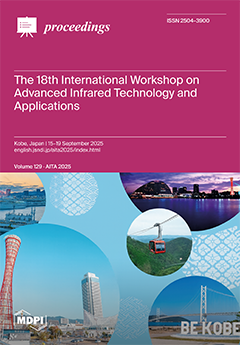Need Help?
Proceedings, 2025, AITA 2025
The 18th International Workshop on Advanced Infrared Technology and Applications
Kobe, Japan | 15–19 September 2025
Volume Editors:
Takahide Sakagami, Kobe University, Greece, Japan
Hirotsugu Inoue, Institute of Science Tokyo, Japan
- Issues are regarded as officially published after their release is announced to the table of contents alert mailing list.
- You may sign up for e-mail alerts to receive table of contents of newly released issues.
- PDF is the official format for papers published in both, html and pdf forms. To view the papers in pdf format, click on the "PDF Full-text" link, and use the free Adobe Reader to open them.
Cover Story (view full-size image):
The AITA (Advanced Infrared Technology and Applications) workshop has been supported continuously by the Fondazione "Giorgio Ronchi", IFAC-CNR, ITC-CNR, ISTI-CNR, IBF-CNR, CNR-ISAC and the
[...] Read more.
The AITA (Advanced Infrared Technology and Applications) workshop has been supported continuously by the Fondazione "Giorgio Ronchi", IFAC-CNR, ITC-CNR, ISTI-CNR, IBF-CNR, CNR-ISAC and the Politecnico di Torino. The 18th AITA2025 is organized by the Japanese Society for Non-Destructive Inspection (JSNDI) and co-organized by Kobe University. It focuses on, but is not limited to, the following topics: Advanced technology and materials; Smart and fiber-optic sensors; Thermo-fluid dynamics and energy; Biomedical applications; Environmental monitoring; Aerospace and industrial applications; Nanophotonics and Nanotechnologies; Astronomy and Earth observation; Non-destructive testing and evaluation; Systems and applications for cultural heritage; Image processing and data analysis; Near-, mid-, and far-infrared systems.
Previous Issue
Next Issue
Issue View Metrics
Multiple requests from the same IP address are counted as one view.



